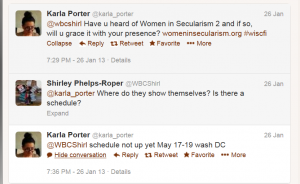Sylvia Browne is getting a lot of flack now, not surprisingly. I can’t manage to feel very sorry for her.
I searched ur-B&W for her name and found quite a lot. That Jon Ronson article I pointed out yesterday is there, in 2007 when it was first published. Below that there’s an article by James Randi, but the link is a dud. There’s one from Stop Sylvia Browne, but that link too is a dud. The very first one is from December 2004 (jeezis) and is about Sylvia Browne’s angelology.
Here it is again.
___________________
Ever read any books about angels? No? No, I hadn’t either, but I’ve read bits of one now, and I must say, if you’re looking for a good laugh, books about angels (if this one is anything to go by, at least) are pretty damn funny. Books about Wicca are quite mirth-inducing, too.
With the angel book, I keep opening it at random, and the first thing I read is so absurd I find myself cackling before I’ve read ten words. I’m beginning to think that every single line of the book is packed full of unintentional humour. Shall I give you a taste? These are just random, mind – I haven’t actually searched out the most risible stuff.
The first one actually isn’t entirely funny, but the basic failure to connect the dots that underlies it, is.
At the time of 9/11, there were many stories of people seeing angels, which of course shows that God sent his legions of blessed angels to escort those dearest of souls to the Other Side and to bring the rest of us a message of hope.
Oh dear kind sweet thoughtful God, sending his blessed angels. Um – why didn’t he just send his blessed angels to stop the God-lovers in the airplanes? Or stop them himself? Because he has a Purpose, which is Inscrutable to us mere mortals. Okay, but in that case, we don’t know anything about it, do we, so why make factual statements of that kind? Because it’s fun, obviously. But the idea behind it – well really. So – little Kevin likes to torture small animals to death, and then when he’s done it he sends blessed angels to escort the souls of his victims to the Other Side. Do we think well of little Kevin? Dear Violet likes to set fire to people’s houses in the middle of the night and watch while the residents are immolated, then in the morning she sends her blessed angels to smooth their way to the Other Side (where, who knows, what greets them may be serried ranks of Kevins and Violets, all grinning fiendishly). In other words, how people can unite the idea of a kind helpful deity sending angels with one who just got through allowing a slow-motion mass murder to happen in the first place, is simply…beyond my humble understanding.
The very next bit:
The Archangels can heal, and they can carry messages, and they can do one more thing as well. They can take us out of our bodies and take us away on an astral trip. To go on an astral trip…we can call on the Archangels to help us, because these messengers can be the ones who come forward and whisk us right up.
Oh! I didn’t know that. Dang, silly me, I just wasted all that money on a plane ticket. I didn’t know one could just call on an Archangel instead. Okay, I see – so if one wants to take a plane one visits Expedia or some such, and if one wants to take an astral trip, one calls an Archangel. Got it. Next time I’ll know.
Another bit, under the heading Angels: Fact and Fiction:
Before we go any further, let’s clear up a few myths about angels. Since we’ve spent so much time talking about what angels are, it’s equally important to go over what they are not.
First of all, contrary to belief, there are no dark angels.
Oh. You know, you’ll hardly believe me, but there’s no footnote for that statement. In fact there are no footnotes in the whole book. Nor is there an index, nor a bibliography. So one’s strong curiosity to know exactly how Sylvia Browne (for it is she) knows this, is doomed to remain unsatisfied. No doubt she has stacks of scholarly references, or perhaps notes of her extensive experimentation and research, but her citation method is a little primitive. Which is to say she left it out entirely. Odd that an angel didn’t remind her. Well, I say ‘entirely’ – but to be fair there is a kind of blanket citation at the beginning, in the ‘Author’s Note.’ She has a guide named Raheim, ‘from India’ (well of course – where would he be from, Trenton N.J.?), and another named Iena, an Aztec-Inca woman (another no-show for the Trentonians), and the two of them have ‘conveyed countless hours of information’ to her. So consider that one big mega-meta-footnote for all factual statements. Astral trips, no dark angels[1]
[1] Iena, Raheim
Kind of pedantic, isn’t it.
(This is a syndicated post. Read the original at FreeThoughtBlogs.)


